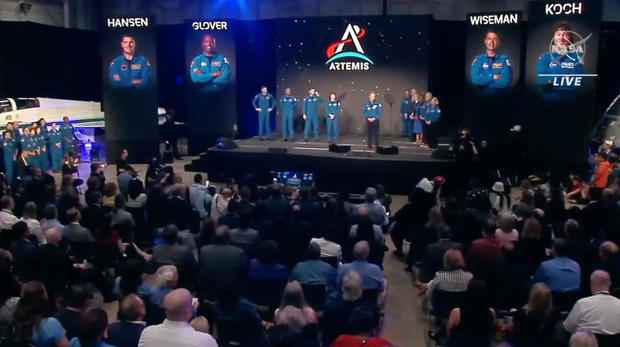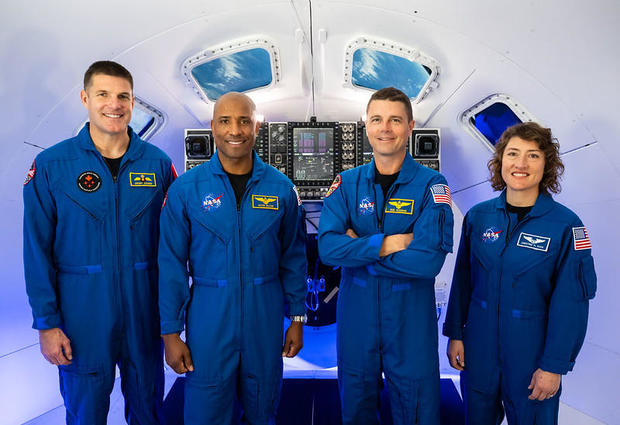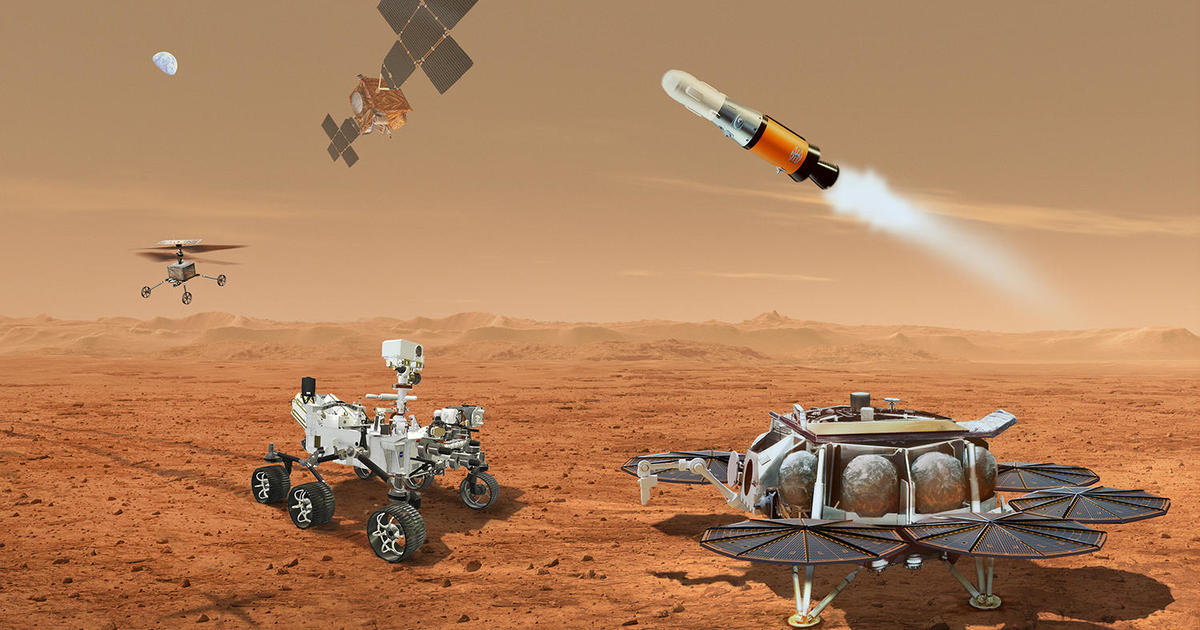NASA introduces 4 astronauts who will fly to the moon on Artemis II mission
A Canadian astronaut and three NASA veterans, including one of the world's most experienced female spacewalkers, will fly around the moon next year in the first piloted voyage beyond Earth orbit since the Apollo program ended 50 years ago, the space agency announced Monday.
NASA's Reid Wiseman, Christina Koch and Victor Glover will join Canadian rookie Jeremy Hansen aboard an Orion crew capsule for the Artemis program's second fight, the first carrying a crew bound for the moon. The Artemis II mission is intended to pave the way toward the first moon landing — Artemis III — in the 2025-26 timeframe.
"Artemis II is more than a mission to the moon and back," Glover said. "It's more than a mission that has to happen before we send people to the surface of the moon. It is the next step on the journey that gets humanity to Mars. ... And this crew will never forget that."
Wiseman, Koch and Glover are all veterans of long-duration stays aboard the International Space Station while Hansen will be making his first space flight.
"It's been more than a half-century since astronauts journeyed to the moon. Well, folks, that's about to change.The mission to the moon will launch four pioneers, but it will carry more than astronauts — Artemis II will carry the hopes of millions of people around the world," NASA Administrator Bill Nelson said before introducing the crew.
Navy Capt. Reid Wiseman, 47, a widowed father of two, is a veteran F/A-18F Super Hornet pilot who holds a master's in systems engineering. He launched aboard a Russian Soyuz spacecraft in 2014 and spent 165 days aboard the space station, then served as chief astronaut after his return to Earth.
Koch, 44, holds a master's in electrical engineering who has experience in Antarctic research. She also launched aboard a Soyuz and spent nearly a full year aboard the lab in 2019-20, venturing outside for six spacewalks, including three all-female excursions. With 42 hours and 15 minutes of EVA time, she ranks third on the list of most experienced female spacewalkers.
Glover, 46, is a Navy captain, a father of four and one of only a half dozen African Americans in NASA's astronaut corps. He launched to the station aboard the first operational SpaceX Crew Dragon mission in 2021-22, logging 168 days in orbit. Glover is a veteran test pilot with more than 3,000 hours of flight time and more than 400 carrier landings.
Hansen, a 47-year-old colonel in the Canadian armed forces and father of three, is a veteran F-18 fighter pilot. He will be the ninth Canadian to fly in space and the first to venture beyond Earth orbit.
A Canadian seat on the historic mission acknowledges Canada's development of the robot arm that was key to assembling the International Space Station and the ongoing development of another arm for NASA's planned Gateway lunar orbit outpost
"So here we have it: Reid, Victor, Christina and Jeremy," Nelson told a packed hangar at Ellington Field near the Johnson Space Center in Houston. "Each of these adventures has their own story, but together, they represent our creed: E pluribus unum: out of many, one.
"Together, we will usher in a new era of exploration for a new generation of star sailors and dreamers, the Artemis generation," he said. "Together, we are going to the moon to Mars, and beyond."
Said Hansen: "There are two reasons why a Canadian is going to the moon. The first one is American leadership. It is not lost on any of us that the United States could choose to go back to the moon by themselves. But America has made a very deliberate choice over decades to curate a global team."
The second reason, he said, was Canada's "can-do attitude."
"For decades now, literally thousands upon thousands of Canadians have risen to that challenge to bring real value to the international partnership with respect to space exploration. ... And all of those have added up to this moment where a Canadian is going to the moon with our international partnership. And it is glorious!"
NASA is focused on operating the space station through 2030 while transitioning to deep space exploration with Artemis missions to the moon and, eventually, piloted flights to Mars. It's anyone's guess how far off a Mars mission might be, but NASA fully intends to land astronauts back on the moon within the next few years.
As the Obama administration was winding down, NASA was tentatively planning a return to the moon toward the end of the decade. But the Trump administration ordered the agency to accelerate those plans, initially calling for astronauts to land on the moon by the end of 2024 — a clearly unrealistic expectation then and now.
Those plans eventually morphed into what NASA calls the Artemis program, a series of missions designed to establish a long-term presence on and around the moon.
Along with ongoing development of the SLS rocket and Orion spacecraft, which will be put to the test in the Artemis II mission, NASA has hired SpaceX to build a lunar lander based on the design of the company's yet-to-fly Starship rocket.
At the same time, NASA contractors are building a mini space station, Gateway, that will be robotically assembled in lunar orbit to serve as a research outpost and staging base for flights to and from the surface.
For Artemis, NASA is targeting the lunar south pole where data from orbiting spacecraft indicate deposits of ice might be present in permanently shadowed craters. Ice could provide future astronauts a valuable source of air, water and rocket propellants — hydrogen and oxygen — to facilitate future deep space exploration.
The first Artemis mission, launched last October, sent an unpiloted Orion capsule around the moon in the maiden flight of NASA's Space Launch System moon rocket.
For the Artemis II mission, Wiseman, Glover, Koch and Hansen will be the first astronauts to launch atop the gargantuan SLS rocket and the first to test the Orion capsule in flight.
They'll spend a day in a high Earth orbit, testing Orion's rendezvous systems, and then fire the spacecraft's service module engine to put the ship on a trajectory that will carry the crew well beyond the moon.
Unlike the historic Apollo 8 crew, which orbited the moon in 1968, the Artemis II crew will not go into orbit or fly closer than about 5,000 miles of the cratered surface. Instead, they will fly a so-called "free-return" trajectory, using the moon's gravity to bend the flight path back toward Earth and a Pacific Ocean splashdown.
"We're going to hear the words 'go for launch' on top of the most powerful rocket NASA's ever made, the Space Launch System, and we're gonna ride that rocket for eight minutes into Earth orbit," Koch said.
"We're not going to go to the moon right away. We're going to stay in an amazing high orbit, reaching a peak of tens of thousands of miles while we test out all the systems on Orion, and even see how it maneuvers in space. And then if everything looks good, we're heading to the moon."
The outbound quarter-million-mile journey will take four days. Along the way, Koch said, the crew will continue testing "every bit of Orion going around the far side of the moon, heading home, going through the Earth's atmosphere at over 25,000 miles per hour and splashing down in the Pacific. So am I excited? Absolutely!"
Assuming Artemis II goes well, NASA plans to send another four astronauts to the moon in the 2025-26 timeframe — Artemis III — including the next man and the first woman to walk on the moon.
NASA has also said the Artemis program will send the first person of color to the lunar surface, although it's not yet known whether that yet-to-be-named astronaut will be assigned to the Artemis III crew or a downstream mission.
One of the biggest unknowns at this point is the status of the Starship lander.
The Starship relies on SpaceX's huge super-heavy booster to reach Earth orbit, followed by multiple refueling missions to load it up with enough cryogenic propellants to head for the moon. One unpiloted moon landing is planned before the Artemis III flight with astronauts aboard.
SpaceX is gearing up to launch the first super heavy/Starship on an unpiloted maiden test fight around Earth. Whether SpaceX can launch enough test flights over the next two to three years to give NASA the confidence it will need for a piloted lunar landing mission remains to be seen.








